Abstract
Euglena gracilis produce high amounts of algal β-1,3-glucan, which evoke an immune response when consumed. This study investigated the effect of supplementation with a proprietary Euglena gracilis fermentate (BG), containing greater than 50% β-1,3-glucan, on immune function as measured by self-reported changes in upper respiratory tract infection (URTI) symptoms. Thirty-four healthy, endurance-trained participants were randomized and received either 367 mg of BG or placebo (PLA) for 90 days. Symptoms were assessed by the 24-item Wisconsin Upper Respiratory Symptom Survey and safety via clinical chemistry, hematology, vitals, and adverse event reporting. Participants supplemented with BG over 90 days reported fewer sick days (BG: 1.46 ± 1.01; PLA: 4.79 ± 1.47 days; p = 0.041), fewer URTI symptoms (BG: 12.62 ± 5.92; PLA: 42.29 ± 13.17; p = 0.029), fewer symptom days (BG: 5.46 ± 1.89; PLA: 15.43 ± 4.59 days; p = 0.019), fewer episodes (BG: 2.62 ± 0.67; PLA: 4.79 ± 0.67; p = 0.032), and lower global severity measured as area under curve for URTI symptoms (BG: 17.50 ± 8.41; PLA: 89.79 ± 38.92; p = 0.0499) per person compared to placebo. Sick days, symptoms, and global severity were significantly (p < 0.05) fewer over 30 days in the BG group compared to PLA. All safety outcomes were within clinically normal ranges. The study provides evidence that supplementation with a proprietary Euglena gracilis fermentate containing greater than 50% β-1,3-glucan may reduce and prevent URTI symptoms, providing immune support and protecting overall health.
1. Introduction
Upper respiratory tract infections (URTI) cause cold- and flu-like symptoms and are the most common form of acute illness with roughly 70% of the general population experiencing at least one episode annually [,,,,]. Lost productivity due to cold- and flu-like symptoms has a drastic impact on the economy with an estimated 40 million missed work or school days each year, translating to over $40 billion in lost economic potential []. Supplementation with naturally occurring bioactive molecules and functional foods can have a beneficial effect on immune function [] and it may be a potential strategy for preventing productivity losses due to colds.
Euglena gracilis is a micro-algae of the division Euglenophyceae and family Euglenales []. Classified as a protist, Euglena gracilis can synthesize many nutrients under autotrophic and heterotrophic growth conditions, including protein, omega-3 fatty acids, vitamin C, vitamin E, and other anti-oxidants []. Omega-3 fatty acids can regulate both innate and adaptive immunity [] and vitamin C and E supplementation can enhance immune function by increasing neutrophil chemotaxis and phagocytosis and by modulating T cell function, respectively [,]. Importantly, E. gracilis produces paramylon, a high molecular weight, linear, unbranched, insoluble β-1,3-glucan, which acts as energy storage within the cell. Previous research has linked insoluble β-1,3-glucans with human immunity. β-1,3-glucans carry non-self, pathogen-associated molecular patterns (PAMPs) that are non-specifically recognized by cell surface receptors in the body, prompting an innate immune response []. Consequently, supplementation with E. gracilis has the potential to support immune function [,,].
Monitoring the variable incidence of URTI symptoms in a healthy population is challenging and requires that participants are followed for a sufficient duration, thereby presuming an eventual occurrence of a URTI. Certain stressors, however, such as exercise, lifestyle, and psychological stress, can negatively affect the immune response. These stressors provide an opportunity to verify immune support benefits of interventions in healthy individuals. Previous studies have recruited populations such as healthcare providers or firefighters [,]. Additionally, active individuals participating in endurance training at higher levels of intensity and duration experience higher rates of cold- and flu-like symptoms than the general population []. The increased prevalence of cold- and flu-like symptoms is attributed to a hormetic relationship between exercise and immune function, with higher levels of exercise leading to transient immunosuppression [,]. Exercise-induced immunosuppression can last from 24 h [,] to 2 weeks [] following training sessions or endurance events. The disruption in immunity caused by endurance exercise may be minimized by immunonutrition []. Therefore, endurance-trained individuals may provide an ideal population to study the effects of a supplementation regimen intended to strengthen the immune system in healthy individuals. The purpose of this study was to investigate the potential immunomodulating effects of a proprietary Euglena gracilis fermentate (BG) containing greater than 50% β-1,3-glucan measured by self-reported changes in URTI symptoms in healthy, active individuals at greater risk for URTI over 90 days compared to a placebo.
2. Materials and Methods
The study was approved by the institutional review board (IRB Services, Aurora, Ontario, Canada) on 5 January 2018 (Pro00023994) and by Health Canada (#233692). The trial was performed according to the ethical guidelines detailed in the Declaration of Helsinki (2008) and complied with the International Council for Harmonization of Technical Requirements for Pharmaceuticals for Human Use (ICH) guidelines. Researchers strictly followed the ICH guidelines for Good Clinical Practice Current Step 4 Version, dated 10 June 1996. The researchers also ensured the archiving of essential documents. The present study was registered at clinicaltrials.gov (NCT03518281) prior to recruitment and followed the CONSORT guidelines for randomized controlled trials [] (Supplementary Table S1). After the study was explained verbally, written information was provided, written consent was obtained, and a copy of the consent was provided to the participant.
2.1. Investigational Product
The Euglena gracilis fermentate (Commercial name BetaViaTM Complete, Kemin Foods LC, Des Moines, IA, USA) was produced from the Euglena gracilis Kelbs var. bacillaris ATCC PTA-123017 strain. The 1,3-β-glucan content in BetaVia Complete was quantified by compendial methods for total dietary fiber (TDF) according to the AOAC Official Method 991.43 Total, Soluble, and Insoluble Dietary Fiber in Foods.
Nuclear magnetic resonance spectroscopy was used for structural analysis of β-glucans, providing information on the glycosidic linkages. The acquired spectra for BetaVia Complete precipitate fractions agree by chemical shift, integration, and coupling constant with a commercially acquired paramylon sample and literature reports for 1,3-β-glucan [,].
Genotoxocity and subchronic toxicity studies of the dried fermentate from the same proprietary strain of E. gracilis found no evidence of toxicity up to the limit of 50,000 ppm from diet. The authors also found no mutagenic properties and there were no signs of gross toxicity, adverse effects, or abnormal behavior as the rats appeared active and healthy throughout the study. In addition, BG has widespread use in conventional food products, which have been regulated for food-grade specifications and BetaVia Complete has been affirmed as Generally Recognized as Safe for use in a variety of food and beverage applications. As such, it was deemed safe for human consumption [].
2.2. Study Design
The present study was a 90-day single-center, randomized, double-blind, placebo-controlled, parallel-group trial conducted at the KGK Science Inc. clinical trial center in London, Ontario, Canada from 19 January 2018 to 10 August 2018. Participants were asked to consume one capsule containing 367 mg of BG or placebo (PLA; microcrystalline cellulose) once daily 30 min before breakfast for a duration of 90 days. There were no differences in size, color, taste, or texture between BG and PLA.
2.3. Study Population
Generally healthy, endurance-trained (1.5–3 h/day of endurance exercise or sport, 5–6 days/week) men and women between 21 and 65 years of age with a body mass index ranging from 18 to 35 kg/m2 who were willing to maintain a consistent diet and lifestyle (including exercise) routine were included in the study. At the initial screening visit, participants underwent a physical examination by a physician including routine hematology, clinical chemistry, and vitals to confirm health status. Inclusion and exclusion criteria are detailed in Table 1. As per the original protocol, flu vaccination was an exclusion criterion and individuals that had received the flu vaccine were not enrolled into the study. Based on the 2017–2018 data, the flu vaccine was reported to be only 10–20% effective against the major viral strain in Canada (H3N2). Therefore, it was expected that the vaccine may not have a major impact on the study outcomes and individuals who received the vaccine could participate in the study. A mid-study amendment was made to remove the flu vaccination as an exclusion criterion.

Table 1.
Inclusion and exclusion criteria.
2.4. Study Procedure
The schematic depiction of the study design is shown in Figure 1. The study included three visits to the clinical trial center: screening (Visit 1), baseline (Visit 2), and post-supplementation (Visit 3). Safety parameters were measured at clinic visits, while efficacy was determined via daily administration of the Wisconsin Upper Respiratory Symptom Survey-24 (WURSS-24) during the 90-day supplementation period. At Visit 1, potential participants were screened via medical history, inclusion/exclusion criteria, concomitant therapies, and current health status. At Visit 2 (baseline), participants were randomized into either BG or PLA groups. After 90 days of supplementation, participants returned for Visit 3, where efficacy and compliance were assessed, and safety was measured.
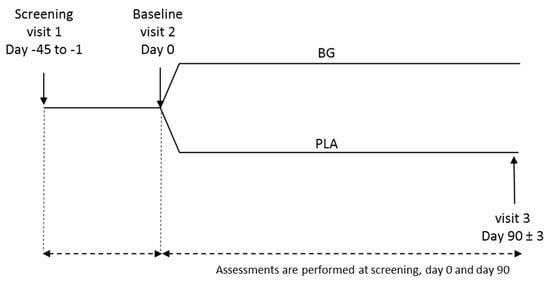
Figure 1.
Study flow diagram.
A block randomization list was generated by unblinded personnel at KGK Science Inc. who were not involved in any data collection. Block randomization with a block size of 4 was implemented, such that two participants each were allocated to BG and PLA groups within each block in a random fashion. A randomization schedule that matched sequentially numbered containers to potential participants (who were assigned separate randomization numbers at baseline) was provided to the investigator, and all participants and site personnel involved in data collection were blinded to the product. Emergency unblinding envelopes were prepared for each participant. This randomization process allowed for the possibility of unblinding individual participants—in case of emergency—without unblinding the entire study. The study was unblinded after data collection was completed and initial study reports with statistical analyses were prepared.
2.5. Wisconsin Upper Respiratory Symptom Survey-24 (WURSS-24)
The validated WURSS-24 questionnaire was administered daily to assess URTI incidence, duration, and severity []. It consists of 2 general URTI questions, 13 symptom-related questions, and 9 quality of life or daily functioning questions. The responses are rated from 0 (not sick or no symptom) to 7 (severely or severe), with a maximum total score of 91 and 63 for symptom-related and daily-functioning questions, respectively. A higher score is indicative of a more severe cold and a greater number of cold symptoms. The cold symptoms assessed included runny nose, plugged nose, sneezing, sore throat, scratchy throat, cough, hoarseness, head congestion, chest congestion, feeling tired, headache, body aches, and fever.
2.6. Outcomes
In the present study, the primary outcome was the percentage of participants with very mild, mild, moderate, or severe URTI symptoms in the BG group and the PLA group after 30 or 90 days of supplementation.
Secondary outcomes included: (1) number of sick days per person (defined as days scored as “sick”); (2) the total number of URTI symptoms experienced per person; (3) number of days with URTI symptoms per person; (4) number of URTI episodes per person (defined as the appearance of one or more symptoms with at least two days of “not sick” in between); and (5) global severity of symptoms per person determined by the mean area under the curve (AUC) for WURSS-24 daily symptom scores during 30 or 90 days of supplementation with BG or PLA [,].
2.7. Safety
Safety measurements included hematology, clinical chemistry, and vital signs. Pre- and post-supplementation blood samples were collected via venipuncture by a phlebotomist and analyzed for complete blood count and clinical chemistry (sodium, potassium, chloride, calcium, creatinine, estimated glomerular filtration rate (eGFR), aspartate aminotransferase (AST), alanine aminotransferase (ALT), and bilirubin). Vital signs (systolic and diastolic blood pressure and heart rate) were measured via an automated digital sphygmomanometer (American Diagnostic Corporation Model No. 6022). In addition to the above, participants were queried on adverse events (AEs) throughout the trial.
2.8. Statistical Analyses
Power calculations were performed using the test of two proportions to determine the required sample size to provide 80% power at the 0.05 alpha level based on the primary outcome, which was a comparison of the percentage of participants with URTI symptoms between the BG group and the PLA group. In total, 60 participants were required at enrollment, based on an estimated 20% attrition over the course of this study, to detect a 45% difference in the incidence of URTI symptoms between groups [].
All analyses were performed by an independent, third-party statistician using SAS for Windows version 9.3 (SAS Institute Inc, Cary, NC, USA); a two-tailed p value of <0.05 was considered statistically significant. All data are presented as mean ± standard error of the mean (SEM). Between-group differences for the primary outcome, demographics, and adverse events were assessed by the chi-squared or Fisher’s exact test, where appropriate. All secondary outcomes were assessed by ANOVA, wherein the data collected from Day 1 to Day 30 and Day 1 to Day 90 were compared between groups. Safety outcomes were assessed by ANOVA and compared from screening to Day 90 between groups.
The safety population consisted of all participants who received capsules and with any available post-randomization efficacy information. The per protocol (PP) population included all participants who consumed at least 80% of either study product, did not have any major protocol violations, and completed all study visits and procedures connected with measurement of the primary variables. Efficacy outcomes were analyzed in the PP population while safety outcomes were analyzed in the safety population.
Post-hoc analyses, not initially described in the statistical analysis plan, were conducted on individual symptoms and total overall (symptom plus functional) outcomes by ANOVA. The statistician remained blinded throughout the process of analyzing data.
3. Results
A total of 79 participants were screened and 34 eligible participants were enrolled in the study with 17 participants each in the BG and PLA groups (Figure 2). Thirty-two participants completed the study, and five participants were removed from the per protocol (PP) analysis for non-compliance regarding product, data reporting, or exclusionary medication, resulting in a PP of 13 and 14 in the BG and PLA groups, respectively. Recruitment into the study was terminated early to ensure data collection during a single cold and flu season—as verified by incidence rates by the Middlesex London Health Unit (London, Ontario) []—thereby limiting the impact of seasonal variation of exercise and dietary behaviors in endurance-trained individuals. The demographic details of the participants are provided (Table 2). Both groups were well-balanced with no significant differences observed in age, sex, or ethnicity between groups. Product compliance was 98.90% and 100.00% in the BG and PLA groups, respectively.
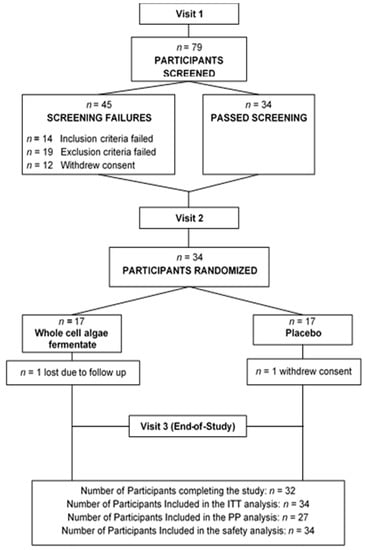
Figure 2.
Disposition of study participants. From the whole cell algae fermentate group, 3 participants were removed from the PP population, 1 for non-compliance and 2 for missing >10% of primary endpoint data. From the placebo group,2 participants were removed from the PP population, 1 for non-compliance and 1 for immunomodulatory use.

Table 2.
Demographic characteristics of participants with whole cell algae fermentate (BG) and placebo (PLA) in the PP population (n = 27).
Regarding the primary outcome, the percentages of participants reporting URTI symptoms are detailed in Table 3. Between-group differences for very mild, mild, moderate, severe, or any symptoms were not statistically significant, although a trend was observed in very mild symptoms from Day 1 to Day 90 (p = 0.098).

Table 3.
Percentage (%) of participants with URTI symptoms from Day 1 to Day 30, and from Day 1 to Day 90 of supplementation with whole cell algae fermentate (BG) or placebo (PLA) in the PP population (n = 27).
Regarding secondary outcomes, participants in the BG group reported significantly fewer sick days compared to PLA from Day 1 to Day 30 (BG: 0.69 ± 0.55 days; PLA: 2.00 ± 0.83 days; p = 0.047) and Day 1 to Day 90 (BG: 1.46 ± 1.01 days; PLA: 4.79 ± 1.47 days; p = 0.041) (Figure 3). URTI symptoms per person were significantly lower in the BG group from Day 1 to Day 30 (BG: 6.08 ± 2.79; PLA: 20.64 ± 7.41; p = 0.042) and from Day 1 to Day 90 (BG: 12.62 ± 5.92; PLA: 42.29 ± 13.17; p = 0.029) than the PLA group (Figure 4). Symptom days per person were significantly lower in the BG group from Day 1 to Day 90 (BG: 5.46 ± 1.89 days; PLA: 15.43 ± 4.59 days; p = 0.019) than the PLA group (Figure 5). URTI episodes per person were significantly lower in the BG group from Day 1 to Day 90 (BG: 2.62 ± 0.67; PLA: 4.79 ± 0.67; p = 0.032) than the PLA group (Figure 6). Global severity was significantly lower in the BG group from Day 1 to Day 30 (BG: 7.19 ± 3.22; PLA: 42.54 ± 19.32; p = 0.043) and Day 1 to Day 90 (BG: 17.50 ± 8.41; PLA: 89.79 ± 38.92; p = 0.0499) compared to PLA (Figure 7).
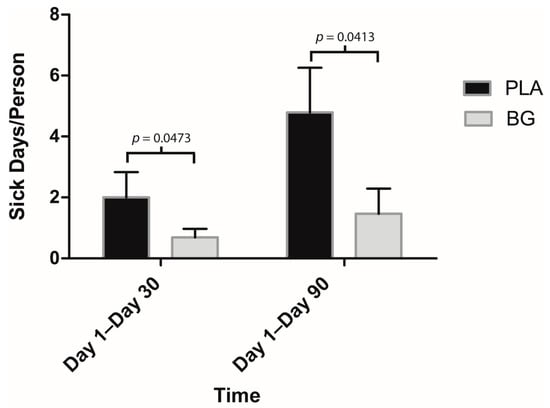
Figure 3.
Mean number of sick days per person after 30 and 90 days of supplementation with BG or PLA in the PP population (n = 27). Values are mean ± SEM. BG, whole cell algae fermentate; PLA, placebo.
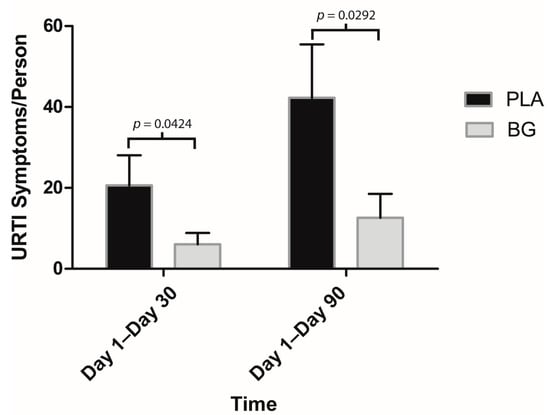
Figure 4.
Number of URTI symptoms per person after 30 and 90 days of supplementation with BG or PLA in the PP population (n = 27). Values are mean ± SEM. BG, whole cell algae fermentate; PLA, placebo.
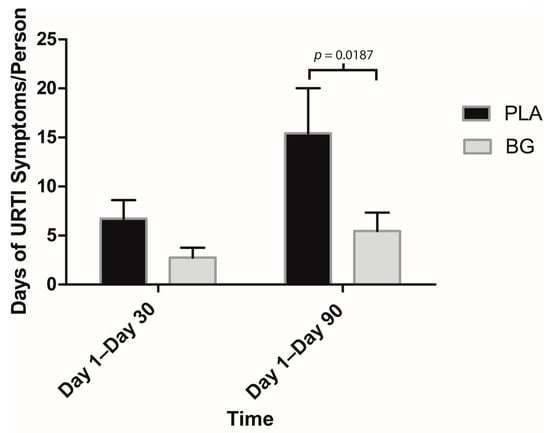
Figure 5.
Mean number of days with at least one reported URTI symptom per person as assessed by the WURSS-24 daily questionnaire after 30 and 90 days of supplementation with BG or PLA in the PP population (n = 27). Values are mean ± SEM. BG, whole cell algae fermentate; PLA, placebo.
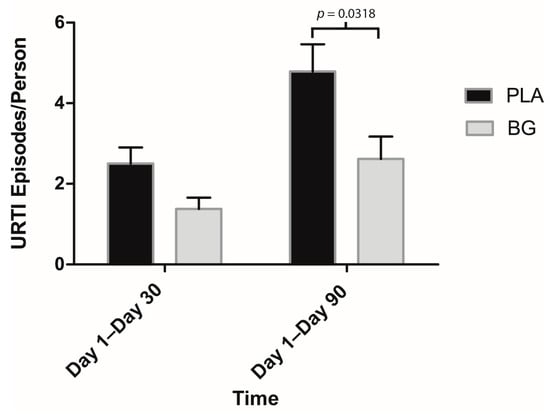
Figure 6.
Mean number of URTI episodes per person after 30 and 90 days of supplementation with BG or PLA in the PP population (n = 27). Values are mean ± SEM. BG, whole cell algae fermentate; PLA, placebo.
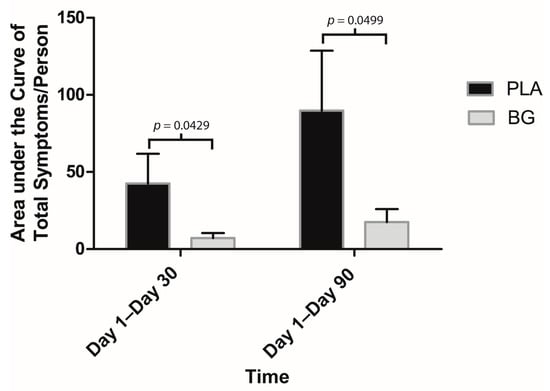
Figure 7.
Mean area under the curve (AUC) for WURSS-24 daily symptoms after 30 and 90 days of supplementation with BG or PLA in the PP population (n = 27). Values are mean ± SEM. BG, whole cell algae fermentate; PLA, placebo.
The post-hoc analysis revealed that some individual symptoms were affected by supplementation with BG (Figure 8 and Figure 9). The duration of a sore throat was significantly lower in the BG group from Day 1 to Day 90 (BG: 0.54 ± 0.29 days; PLA: 2.71 ± 0.80 days; p = 0.011) compared to PLA. The severity of a sore throat was significantly lower in the BG group from Day 1 to Day 90 (BG: 0.01 ± 0.00; PLA: 0.06 ± 0.02; p = 0.011) compared to PLA. The duration of a headache was significantly lower in the BG group from Day 1 to Day 30 (BG: 0.38 ± 0.18 days; PLA: 1.86 ± 0.54 days; p = 0.020) and from Day 1 to Day 90 (BG: 0.92 ± 0.43; PLA: 3.93 ± 1.15; p = 0.026) compared to PLA. The severity of a headache was significantly lower in the BG group from Day 1 to Day 30 (BG: 0.02 ± 0.01; PLA: 0.14 ± 0.05; p = 0.043) compared to PLA. The duration of body aches was significantly lower in the BG group from Day 1 to Day 30 (BG: 0.00 ± 0.00 days; PLA: 1.43 ± 0.72 days; p = 0.002) compared to PLA. The severity of body aches was significantly lower in the BG group from Day 1 to Day 30 (BG: 0.00 ± 0.00; PLA: 0.07 ± 0.03; p = 0.002) compared to PLA. The duration of feeling tired was significantly lower in the BG group from Day 1 to Day 30 (BG: 1.31 ± 0.66 days; PLA: 5.00 ± 1.86 days; p = 0.0187) compared to PLA. The severity of feeling tired was significantly lower in the BG group from Day 1 to Day 90 (BG: 0.05 ± 0.02; PLA: 0.40 ± 0.22; p = 0.012) compared to PLA. Overall outcomes (symptom plus functional) are displayed in Figure 10. The overall outcomes were significantly lower in the BG group from Day 1 to Day 30 (BG: 0.32 ± 0.17; PLA: 2.38 ± 1.19 p = 0.029) compared to PLA.
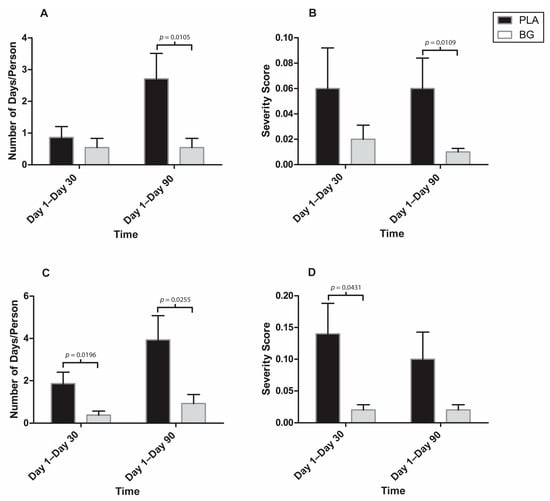
Figure 8.
Individual WURSS-24 symptoms after 30 and 90 days of supplementation with BG or PLA in the PP population (n = 27) as assessed during post-hoc analysis. (A): Days with sore throat. (B): Severity score for sore throat. (C): Days with headache. (D): Severity score for headache. Values are mean ± SEM. BG, whole cell algae fermentate; PLA, placebo.
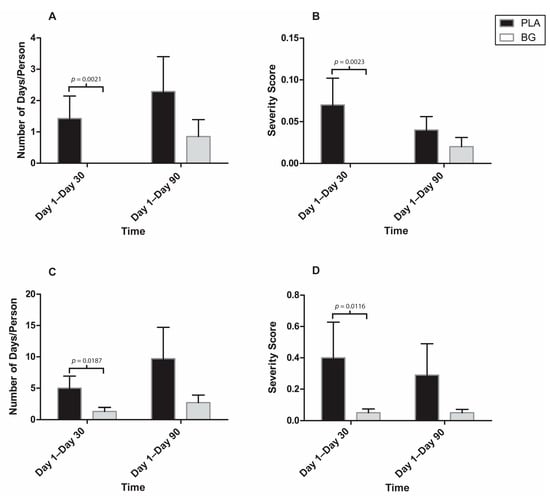
Figure 9.
Individual WURSS-24 symptoms after 30 and 90 days of supplementation with BG or PLA in the PP population (n = 27) as assessed during post-hoc analysis: (A) days with body aches; (B) severity score for body aches; (C) days with symptom of feeling tired; and (D) severity score for symptom of feeling tired. Values are mean ± SEM. BG, whole cell algae fermentate; PLA, placebo.
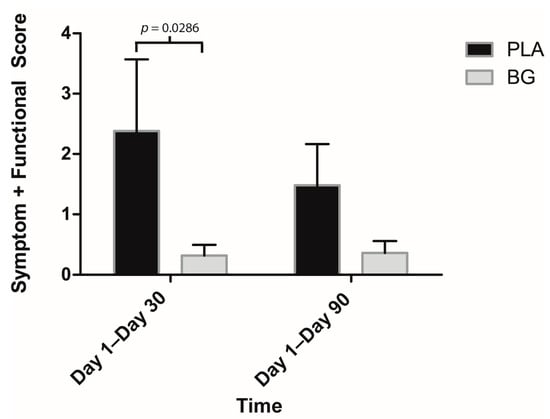
Figure 10.
Score of symptoms plus functional outcomes from WURSS-24 after 30 and 90 days of supplementation with BG or PLA in the PP population (n = 27) as assessed during post-hoc analysis. Values are mean ± SEM. BG, whole cell algae fermentate; PLA, placebo.
Safety data are presented in Table 4 and Table 5. No significant differences were observed in vital signs or hematology (Table 5). In clinical chemistry measurements, potassium was significantly different between groups (BG: −0.01 ± 0.16 mmol/L; PLA: −0.27 ± 0.10 mmol/L; p = 0.004); however, the change in the PLA group was numerically larger than in the BG group, and all values were within the normal range for healthy adults. Therefore, this finding was considered clinically insignificant. The number of participants reporting AEs was not significantly different between groups. None of the AEs were categorized as “likely related” or “related” to the study products. No participants required medical treatment or hospitalization (i.e., no serious adverse events) and all AEs were resolved by the end of the study.

Table 4.
Clinical chemistry parameters measured in participants in the safety population with whole cell algae fermentate (BG) or placebo (PG) at screening (Visit 1) and Day 90 (Visit 3) (n = 34).

Table 5.
Hematology parameters measured in participants in the safety population with whole cell algae fermentate (BG) or placebo (PLA) at screening (Visit 1) and Day 90 (Visit 3) (n = 34).
4. Discussion
To our knowledge, this is the first study to demonstrate significant benefits regarding URTI symptoms when supplementing with an algae-based fermentate in humans. Endurance-trained individuals supplemented with BG reported fewer sick days, URTI symptoms, URTI symptom days, URTI episodes, and lower global severity than those taking placebo. These findings suggest that incidence, duration, and severity of URTI symptoms were improved from BG supplementation over 90 days. Significant reductions in sick days, symptoms per person, and global severity were detected as early as the 30-day timepoint. Additionally, post-hoc analyses revealed benefits for specific symptoms, such as sore throat, headache, body aches, and feelings of tiredness. Post-hoc analyses showed improvement in overall outcomes via symptom plus functional outcome scores. Safety analyses measuring hematology, clinical chemistry, and vitals corroborated previous animal research [], which confirmed BG to be safe and well-tolerated. No adverse events were reported that could be attributed to BG.
The novel findings in the current randomized, double-blind, placebo-controlled study on BG demonstrated efficacy in supporting immune health in endurance-trained individuals over a three-month period. Previous studies investigating URTI symptoms in similar populations have utilized marathons or intense exercise in the laboratory to stimulate transient immunosuppression over a shorter duration [,]. Talbott et al. found that for two weeks and four weeks post-marathon, fewer runners reported URTI symptoms when supplementing with a yeast-derived β-glucan supplement []. In a similar study, supplementing with yeast-derived β-glucan for 28 days post-marathon resulted in fewer URTI symptom days []. Importantly, the present study extended previous findings under conditions of acute, exercise-induced immunosuppression by demonstrating benefits over a longer duration in exercising individuals who may be at higher risk for URTI due to their typical exercise regimen. Previous studies conducted with yeast-derived β-glucan supplementation evaluating URTI over a 90-day period examined older adults and stressed women, who may also be at higher risk for developing URTI [,]. Therefore, the present study was the first study to investigate the efficacy of a β-glucan product in endurance-trained individuals over a three-month period.
Post-hoc evaluation of specific symptoms and quality of life outcomes revealed that sore throat, headache, body aches, and feelings of tiredness were significantly lower in duration and severity in BG compared to PLA. These data are consistent with the literature following β-glucan consumption. A double-blind, randomized, placebo-controlled parallel study found severity ratings for sore throat were lower post-marathon when supplemented with β-glucan []. While feeling tired is considered a cold symptom on the WURSS-24, it also affects daily functioning. Additionally, improvements were observed with BG in symptom plus functional outcome scores. Feldman et al. showed that participants reported a higher quality of life after consuming β-glucan for 12 weeks of cold and flu season []. These data suggest that BG may have a positive impact on certain aspects of daily functioning and quality of life in endurance-trained individuals.
The findings from this study are not surprising given the significant amount of research linking insoluble β-(1,3)-glucan (with and without β-(1,6)-linkages) from various sources with human immunity [,,,]. β-(1,3)-glucans are recognized by specific pathogen recognition receptors on immune cells including dectin-1, toll-like receptors (TLRs), complement receptor 3 (CR3), scavenger receptor, and lactosylceramide [,,,,]. Notably, the main receptor for β-(1,3)-glucan is dectin-1 [,,,]. Recognition of β-(1,3)-glucan by the dectin-1 receptor triggers an innate immune response that mediates protection against microbes [,]. Importantly, while dectin-1 can bind both soluble and particulate/insoluble β-(1,3)-glucan, only particulate β-glucan, such as the BG in this study, appears capable of activating dectin-1 signaling to initiate an immune response []. The present findings indicate that BG supports the immune system in a clinically relevant manner by maintaining health that was noted through reduced incidence, duration, and severity of URTI symptoms, which were all observed in the current study.
Some limitations exist regarding the current study. Due to the inclusion and exclusion criteria, there were challenges in recruitment. To control for seasonal variations in URTI incidence and lifestyle behaviors such as exercise participation and dietary intake, the enrollment period was terminated before the a priori defined number of participants were recruited. Nonetheless, statistical significance was still achieved for multiple outcomes from the WURSS-24 and these outcomes were aligned with and supported by the literature on yeast β-glucan ingredients supplemented for 90 days or greater [,,]. This was also the likely reason there were no statistically significant findings in the primary outcome, although trends were observed in very mild symptoms. In addition, the primary outcome was based on a previous study measuring symptoms in a similar population consuming a β-glucan supplement where suppression of the immune system was initiated by a marathon, whereas the current study tested over a longer duration without utilizing a single bout of exercise for immunosuppression []. Therefore, an outcome such as sick days or global severity may be a more sensitive measurement in the current study design.
5. Conclusions
In conclusion, the current study showed the ability of a proprietary Euglena gracilis fermentate with >50% β-(1,3)-glucan and >15% protein to support the immune system with a significant reduction in self-reported sick days, total number of symptoms, number of days with symptoms, number of URTI episodes, and global severity of symptoms in endurance-trained individuals. As a novel source of algal β-(1,3)-glucan, BG derived from a proprietary strain of Euglena gracilis might be a valuable addition to nutritional supplementation. It is beneficial by proactively lessening the burden of URTI symptoms in individuals whose diets and lifestyles do not support optimal immune function and health. The effect of nutritional supplements on the immune response is a burgeoning area for researchers, and BG supplementation presents a promising strategy to support a healthy immune system.
Supplementary Materials
The following are available online at https://www.mdpi.com/2072-6643/11/12/2926/s1, Table S1: CONSORT 2010 checklist of information to include when reporting a randomised trial.
Author Contributions
Conceptualization, M.E., J.A.L., E.P.F., and K.A.H.; methodology, M.E., D.C.C., P.H.F., J.A.L., E.P.F., and K.A.H.; software, A.M.S.; validation, M.E., N.Z., A.M.S., K.A.H., and P.H.F.; formal analysis, M.E., N.Z., and A.M.S.; investigation, M.C. and D.C.C.; resources, P.H.F., J.A.L., E.P.F., and K.A.H.; data curation, M.C.; writing—original draft preparation, M.E., A.M.S., P.H.F., J.A.L., E.P.F., and K.A.H.; writing—review and editing, M.E., A.M.S., P.H.F., J.A.L., E.P.F., and K.A.H.; visualization, M.E., A.M.S., P.H.F., and K.A.H.; supervision, M.E. and D.C.C.; project administration, M.E. and M.C.; and funding acquisition, P.H.F., J.A.L., E.P.F., and K.A.H.
Funding
This research was funded by Kemin Foods, L.C., IA, USA.
Acknowledgments
The authors are grateful to Laura Wonderling, Chris Sadewasser, Shweta Shah, and Anisha Rathi for their assistance with data interpretation and review.
Conflicts of Interest
As indicated, some of the authors are employees of Kemin Foods, L.C., the sponsor company. All other authors have no actual or potential conflicts of interest to report. As such, the results of this study are presented clearly, honestly, and without fabrication, falsification, or inappropriate data manipulation.
References
- Barrett, B.; Brown, R.L.; Mundt, M.P.; Thomas, G.R.; Barlow, S.K.; Highstrom, A.D.; Bahrainian, M. Validation of a short form Wisconsin Upper Respiratory Symptom Survey (WURSS-21). Health Qual. Life Outcomes 2009, 7, 76. [Google Scholar] [CrossRef] [PubMed]
- Douglas, R.M. Respiratory tract infections as a public health challenge. Clin. Infect. Dis. 1999, 28, 192–194. [Google Scholar] [CrossRef] [PubMed]
- Gwaltney, J.M., Jr.; Hendley, J.O.; Simon, G.; Jordan, W.S., Jr. Rhinovirus infections in an industrial population: The occurrence of illness. New Engl. J. Med. 1966, 275, 1261–1268. [Google Scholar] [CrossRef]
- Monto, A.S.; Ullman, B.M. Acute respiratory illness in an American community: The Tecumseh study. JAMA. 1974, 227, 164–169. [Google Scholar] [CrossRef]
- Dingle, J.H.; Badger, G.F.; Jordan, W.S., Jr. Illness in the Home. A Study of 25,000 Illnesses in a Group of Cleveland Families; The Press of Western Reserve University: Cleveland, OH, USA, 1964; p. 398. [Google Scholar]
- Fendrick, A.M.; Monto, A.S.; Nightengale, B.; Sarnes, M. The economic burden of non-influenza-related viral respiratory tract infection in the United States. Arch. Intern. Med. 2003, 163, 487–494. [Google Scholar] [CrossRef]
- Wu, D.; Lewis, E.D.; Pae, M.; Meydani, S.N. Nutritional Modulation of Immune Function: Analysis of Evidence, Mechanisms, and Clinical Relevance. Front. Immunol. 2018, 9, 3160. [Google Scholar] [CrossRef]
- Krajcovic, J.; Matej, V.; Schwartzbach, S.D. Euglenoid flagellates: a multifaceted biotechnology platform. J Biotechnol 2015, 202, 135–145. [Google Scholar] [CrossRef]
- Watanabe, F.; Yoshimura, K.; Shigeoka, S. Biochemistry and Physiology of Vitamins in Euglena. Euglena: Biochem. Cell Mol. Biol. 2017, 979, 65–90. [Google Scholar] [CrossRef]
- Lewis, E.D.; Meydani, S.N.; Wu, D. Regulatory role of vitamin E in the immune system and inflammation. IUBMB Life 2019, 71, 487–494. [Google Scholar] [CrossRef]
- Carr, A.C.; Maggini, S. Vitamin C and Immune Function. Nutrients 2017, 9, 1211. [Google Scholar] [CrossRef]
- Russo, R.; Barsanti, L.; Evangelista, V.; Frassanito, A.M.; Longo, V.; Pucci, L.; Penno, G.; Gualtieri, P. Euglena gracilis paramylon activates human lymphocytes by upregulating pro-inflammatory factors. Food Sci. Nutr. 2017, 5, 205–214. [Google Scholar] [CrossRef] [PubMed]
- Monfils, A.K.; Triemer, R.E.; Bellairs, E.F. Characterization of paramylon morphological diversity in photosynthetic euglenoids (Euglenales, Euglenophyta). Phycologia 2011, 50, 156–169. [Google Scholar] [CrossRef]
- Barsanti, L. Paramylon ([beta]-1,3-glucan) content in wild type and WZSL mutant of Euglena gracilis. Effects of growth conditions. J. Appl. Phycol. 2001, 13, 59–65. [Google Scholar] [CrossRef]
- Raina MacIntyre, C.; Chughtai, A.A.; Zhang, Y.; Seale, H.; Yang, P.; Chen, J.; Pan, Y.; Zhang, D.; Wang, Q. Viral and bacterial upper respiratory tract infection in hospital health care workers over time and association with symptoms. BMC Infect. Dis. 2017, 17, 553. [Google Scholar] [CrossRef] [PubMed][Green Version]
- Harger-Domitrovich, S.G. Effects of an Immunomodulating Supplement on Upper Respiratory Tract Infection Symptoms in Wildland Firefighters 2001. Med. Sci. Sports Exerc. 2008, 40. [Google Scholar] [CrossRef][Green Version]
- Gleeson, M.; Pyne, D.B. Respiratory inflammation and infections in high-performance athletes. Immunol. Cell Biol. 2016, 94, 124–131. [Google Scholar] [CrossRef]
- Moraes, H.; Aoki, M.S.; Freitas, C.G.; Arruda, A.; Drago, G.; Moreira, A. SIgA response and incidence of upper respiratory tract infections during intensified training in youth basketball players. Biol. Sport 2017, 34, 49–55. [Google Scholar] [CrossRef]
- Bergendiova, K.; Tibenska, E.; Majtan, J. Pleuran (beta-glucan from Pleurotus ostreatus) supplementation, cellular immune response and respiratory tract infections in athletes. Eur. J. Appl. Physiol 2011, 111, 2033–2040. [Google Scholar] [CrossRef]
- Woods, J.A.; Davis, J.M.; Smith, J.A.; Nieman, D.C. Exercise and cellular innate immune function. Med. Sci. Sports Exerc. 1999, 31, 57–66. [Google Scholar] [CrossRef]
- Carpenter, K.C.; Breslin, W.L.; Davidson, T.; Adams, A.; McFarlin, B.K. Baker’s yeast beta-glucan supplementation increases monocytes and cytokines post-exercise: Implications for infection risk? Br. J. Nutr. 2013, 109, 478–486. [Google Scholar] [CrossRef]
- Peters, E.M.; Bateman, E.D. Ultramarathon running and upper respiratory tract infections. An epidemiological survey. South. Afr. Med. J. 1983, 64, 582–584. [Google Scholar]
- Moher, D.; Hopewell, S.; Schulz, K.F.; Montori, V.; Gotzsche, P.C.; Devereaux, P.J.; Elbourne, D.; Egger, M.; Altman, D.G. CONSORT 2010 explanation and elaboration: updated guidelines for reporting parallel group randomised trials. Int. J. Surg. 2012, 10, 28–55. [Google Scholar] [CrossRef]
- Ensley, H.E.; Tobias, B.; Pretus, H.A.; McNamee, R.B.; Jones, E.L.; William Browder, I.; Williams, D.L. NMR spectral analysis of a water-insoluble (1 → 3)-β-d-glucan isolated from Saccharomyces cerevisiae. Carbohydr. Res. 1994, 258, 307–311. [Google Scholar] [CrossRef]
- Kim, Y.T.; Kim, E.H.; Cheong, C.; Williams, D.L.; Kim, C.W.; Lim, S.T. Structural characterization of β-d-(1 → 3, 1 → 6)-linked glucans using NMR spectroscopy. Carbohydr. Res. 2000, 328, 331–341. [Google Scholar] [CrossRef]
- Simon, R.R.; Vo, T.D.; Levine, R. Genotoxicity and subchronic toxicity evaluation of dried Euglena gracilis ATCC PTA-123017. Regul. Toxicol. Pharmacol. 2016, 80, 71–81. [Google Scholar] [CrossRef]
- Longmier, E.; Barrett, B.; Brown, R. Can patients or clinicians predict the severity or duration of an acute upper respiratory infection? Fam. Pract. 2013, 30, 379–385. [Google Scholar] [CrossRef]
- Johane, G.; Pierre, C.; Pascal, G.; Joerg, G. The Efficacy and Safety of a Patent Pending Combination of Ginger and Goldenrod Extracts on the Management of Cold Symptoms: A Randomized, Double-Blind Controlled Trial. Food Nutr. Sci. 2012, 3, 1651–1657. [Google Scholar]
- Nieman, D.C. Risk of upper respiratory tract infection in athletes: An epidemiologic and immunologic perspective. J. Athl. Train. 1997, 32, 344–349. [Google Scholar]
- 2017–2018 Community Influenza Surveillance Report. Available online: https://www.google.ch/url?sa=t&rct=j&q=&esrc=s&source=web&cd=1&ved=2ahUKEwi1kKmTo5bmAhXMQN4KHa6tBpoQFjAAegQIARAC&url=https%3A%2F%2Fwww.healthunit.com%2Fuploads%2F2017-11-22-community-influenza-surveillance.pdf&usg=AOvVaw3LqkulaqiPzaEdsHrh8LnX (accessed on 1 May 2019).
- McFarlin, B.K.; Carpenter, K.C.; Davidson, T.; McFarlin, M.A. Baker’s yeast beta glucan supplementation increases salivary IgA and decreases cold/flu symptomatic days after intense exercise. J. Diet. Suppl. 2013, 10, 171–183. [Google Scholar] [CrossRef]
- Talbott, S.; Talbott, J. Effect of Beta 1, 3/1, 6 Glucan on Upper Respiratory Tract Infection Symptoms and Mood State in Marathon Athletes. J. Sports Sci. Med. 2009, 8, 509–515. [Google Scholar]
- Fuller, R.; Moore, M.V.; Lewith, G.; Stuart, B.L.; Ormiston, R.V.; Fisk, H.L.; Noakes, P.S.; Calder, P.C. Yeast-derived beta-1,3/1,6 glucan, upper respiratory tract infection and innate immunity in older adults. Nutrition 2017, 39–40, 30–35. [Google Scholar] [CrossRef]
- Talbott, S.M.; Talbott, J.A. Baker’s yeast beta-glucan supplement reduces upper respiratory symptoms and improves mood state in stressed women. J. Am. Coll. Nutr. 2012, 31, 295–300. [Google Scholar] [CrossRef] [PubMed]
- Mah, E.; Kaden, V.N.; Kelley, K.M.; Liska, D.J. Beverage Containing Dispersible Yeast beta-Glucan Decreases Cold/Flu Symptomatic Days After Intense Exercise: A Randomized Controlled Trial. J. Diet. Suppl. 2018, 1–11. [Google Scholar] [CrossRef] [PubMed]
- Feldman, S.; Schwartz, H.I.; Kalman, D.S.; Mayers, A.; Kohrman, H.M.; Clemens, R.; Krieger, D.R. Randomized phase II clinical trials of Wellmune WGP® for immune support during cold and flu season. J. Appl. Res. 2009, 9, 30–42. [Google Scholar]
- Kondo, Y.; Kato, A.; Hojo, H.; Nozoe, S.; Takeuchi, M.; Ochi, K. Cytokine-related immunopotentiating activities of paramylon, a beta-(1 → 3)- D-glucan from Euglena gracilis. J. Pharm. 1992, 15, 617–621. [Google Scholar] [CrossRef] [PubMed]
- Barsanti, L.; Passarelli, V.; Evangelista, V.; Frassanito, A.M.; Gualtieri, P. Chemistry, physico-chemistry and applications linked to biological activities of beta-glucans. Nat. Prod. Rep. 2011, 28, 457–466. [Google Scholar] [CrossRef]
- Brown, G.D.; Taylor, P.R.; Reid, D.M.; Willment, J.A.; Williams, D.L.; Martinez-Pomares, L.; Wong, S.Y.; Gordon, S. Dectin-1 is a major beta-glucan receptor on macrophages. J. Exp. Med. 2002, 196, 407–412. [Google Scholar] [CrossRef]
- Taylor, P.R.; Brown, G.D.; Reid, D.M.; Willment, J.A.; Martinez-Pomares, L.; Gordon, S.; Wong, S.Y. The beta-glucan receptor, dectin-1, is predominantly expressed on the surface of cells of the monocyte/macrophage and neutrophil lineages. J. Immunol. 2002, 169, 3876–3882. [Google Scholar] [CrossRef]
- Adams, E.L.; Rice, P.J.; Graves, B.; Ensley, H.E.; Yu, H.; Brown, G.D.; Gordon, S.; Monteiro, M.A.; Papp-Szabo, E.; Lowman, D.W.; et al. Differential high-affinity interaction of dectin-1 with natural or synthetic glucans is dependent upon primary structure and is influenced by polymer chain length and side-chain branching. J. Pharmacol. Exp. Ther. 2008, 325, 115–123. [Google Scholar] [CrossRef]
- Taylor, P.R. Dectin-1 is required for beta-glucan recognition and control of fungal infection. Nat. Immunol. 2007, 8, 31–38. [Google Scholar] [CrossRef]
- Goodridge, H.S.; Wolf, A.J.; Underhill, D.M. Beta-glucan recognition by the innate immune system. Immunol. Rev. 2009, 230, 38–50. [Google Scholar] [CrossRef]
- Kim, H.S.; Hong, J.T.; Kim, Y.; Han, S.B. Stimulatory Effect of beta-glucans on Immune Cells. Immune Netw. 2011, 11, 191–195. [Google Scholar] [CrossRef] [PubMed]
- Goodridge, H.S.; Reyes, C.N.; Becker, C.A.; Katsumoto, T.R.; Ma, J.; Wolf, A.J.; Bose, N.; Chan, A.S.; Magee, A.S.; Danielson, M.E.; et al. Activation of the innate immune receptor Dectin-1 upon formation of a ‘phagocytic synapse’. Nature 2011, 472, 471–475. [Google Scholar] [CrossRef] [PubMed]
- Auinger, A.; Riede, L.; Bothe, G.; Busch, R.; Gruenwald, J. Yeast (1, 3)-(1, 6)-beta-glucan helps to maintain the body’s defence against pathogens: A double-blind, randomized, placebo-controlled, multicentric study in healthy subjects. Eur. J. Nutr. 2013, 52, 1913–1918. [Google Scholar] [CrossRef]
© 2019 by the authors. Licensee MDPI, Basel, Switzerland. This article is an open access article distributed under the terms and conditions of the Creative Commons Attribution (CC BY) license (http://creativecommons.org/licenses/by/4.0/).